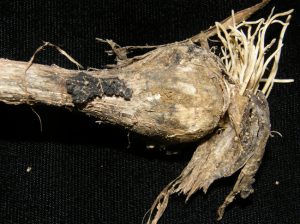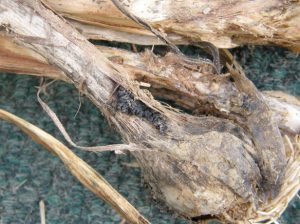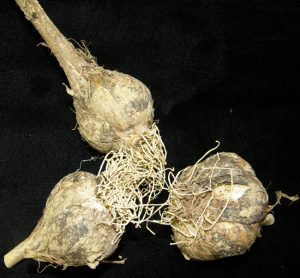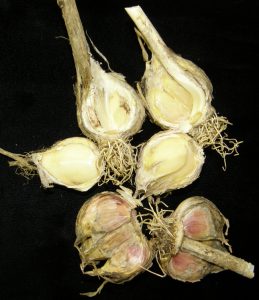Bulletin #1207, Botrytis Neck Rot in Maine Garlic
Botrytis Neck Rot in Maine Garlic (PDF)
Developed by Steven B. Johnson, Extension Crops Specialist, and David Fuller, Extension Professional
For information about UMaine Extension programs and resources, visit extension.umaine.edu.
Find more of our publications and books at extension.umaine.edu/publications/.
Botryotinia (Botrytis) porri is the fungal pathogen that causes neck rot in garlic. This is a relatively new pest in Maine, but because it is readily spread through the planting of infected garlic cloves, it has the potential to become a long-term problem. The pathogen can cause severe damage to garlic grown in backyard gardens as well as on commercial farms.
Botrytis porri is limited to the onion family and also causes neck rot of leek. The disease can cause considerably more damage to garlic under wet conditions than in dryer years. Pathogens that infect garlic bulbs are a threat to seed crops as well as to the commercial garlic industry in Maine, and Botrytis neck rot has damaged garlic and caused losses in recent years. Understanding how the Botrytis neck rot pathogen spreads will help to minimize the serious and long-lasting effects of this harmful crop pest.
Biology
Mold caused by Botrytis porri generally develops on the neck of the garlic plant, later forming sclerotia (rough black masses of hardened fungal mycelium) as large as ¾ inch but typically ¼ inch in diameter. Sclerotia are fungal resting structures that allow Botrytis porri long-term survival as well as survival under periods of unfavorable environmental conditions. Botrytis porri survives the winter as sclerotia in the soil or as sclerotia on infected bulbs.
Moist, cool weather favors sclerotia germination, in which small mushroom-like structures are produced. These structures release tens of thousands of spores that are windcarried to susceptible plants in the onion family and start the disease cycle anew each season. These spores may enter through a wound or directly penetrate the neck (pseudostem); therefore, initial symptoms of the disease may appear near the soil line on garlic necks. Botrytis porri moves rapidly along the neck region of garlic plants, often causing a water-soaked appearance. Warm, wet conditions favor infection and subsequent disease development—excessive water from irrigation or rain is highly conducive to the disease.
Symptoms
In the field, plants infected with Botrytis neck rot are stunted, with dead or dying outer leaves. Symptoms of the infection are often first seen at the soil line on the neck as water-soaked lesions. Under warm and wet conditions, the disease progresses quickly, spreading up the leaves and down the neck. At this time, the large, distinct sclerotia may be present around the rotting neck.
Click on the images to view enlargements.
- Botrytis porri sclerotia on garlic neck. Photo by Steven B. Johnson.
- Botrytis porri sclerotia on garlic neck. Photo by Steven B. Johnson.
- Garlic bulbs infected with Botrytis porri. Photo by Steven B. Johnson.
- Garlic bulbs infected with Botrytis porri. Photo by Steven B. Johnson.
Extensive lesion development can lead to wilting or entire plant death and stand reduction. Plants affected early in the growing season may die completely and be unharvestable. Plants may die mid-season or recover, depending on weather conditions. Infected bulbs that die and decay may have other pathogens attacking them, masking the true cause of the problem. At harvest, alive but badly infected bulbs can be culled. Bulbs that died and remain in the field will be quite likely crusted with sclerotia. These sclerotia serve as initial inoculum for following seasons.
Under dry conditions, disease progress slows or stops and the lesions may dry out and turn brown. Infected bulbs that do not die may have the pathogen present without noticeable symptoms. For this reason, healthy-appearing bulbs from an infected crop should not be used as seed. The disease may develop in storage or in a subsequent crop planted from bulbs that are asymptomatic but infected.
Management
High humidity and wet foliage with prolonged soil wetness will promote Botrytis porri infection and subsequent disease development. Weed control and adequate plant spacing, both in-row, and between-row, will allow air movement, deterring pathogen infection. Botrytis porri sclerotia can survive in the soil for a length of time, so crop rotations in both time and space are crucial in maintaining a Botrytis neck rot-free crop of garlic.
Practices to avoid Botrytis neck rot infestation:
- Use disease-free seed stock.
- Use adequate plant spacing and good weed control to encourage air movement.
- Remove infected plants from the area and do not compost.
- Try to harvest mature plants with a minimum of injury.
- Properly cure garlic bulbs with good air movement.
- Practice proper crop rotation. Do not plant garlic or other alliums in a field where the pathogen is present.
Information in this publication is provided purely for educational purposes. No responsibility is assumed for any problems associated with the use of products or services mentioned. No endorsement of products or companies is intended, nor is criticism of unnamed products or companies implied.
© 2013, 2020
Call 800.287.0274 (in Maine), or 207.581.3188, for information on publications and program offerings from University of Maine Cooperative Extension, or visit extension.umaine.edu.
The University of Maine is an EEO/AA employer, and does not discriminate on the grounds of race, color, religion, sex, sexual orientation, transgender status, gender expression, national origin, citizenship status, age, disability, genetic information or veteran’s status in employment, education, and all other programs and activities. The following person has been designated to handle inquiries regarding non-discrimination policies: Director of Equal Opportunity, 101 North Stevens Hall, University of Maine, Orono, ME 04469-5754, 207.581.1226, TTY 711 (Maine Relay System).





